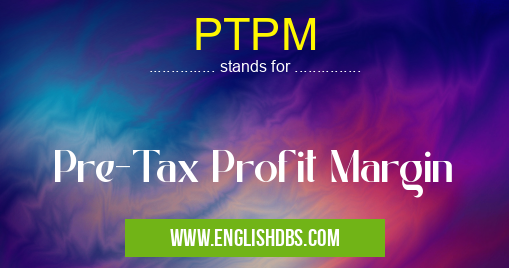What does PTPM mean in ACCOUNTING
Pre-tax Profit Margin, commonly referred to as PTPM, is an important financial metric in the business world. It measures a company’s profitability before taxes are calculated from their total revenues or sales. The pre-tax profit margin ratio gives an indication of how much money a company has remaining after operating expenses, depreciation and amortization are taken into account. This ratio can be helpful for assessing the long-term financial health of a business. It is especially important for investors and other stakeholders when comparing companies within the same industry. By understanding what PTPM means, businesses can better analyze their performance and performance of their competitors to make informed decisions that will improve their overall success

PTPM meaning in Accounting in Business
PTPM mostly used in an acronym Accounting in Category Business that means Pre-Tax Profit Margin
Shorthand: PTPM,
Full Form: Pre-Tax Profit Margin
For more information of "Pre-Tax Profit Margin", see the section below.
» Business » Accounting
Essential Questions and Answers on Pre-Tax Profit Margin in "BUSINESS»ACCOUNTING"
What is Pre-Tax Profit Margin?
Pre-tax profit margin (or PTP margin) is a profitability measure that looks at a company's profits before taxes are deducted. It is calculated by taking the pre-tax profits divided by revenue or net sales for a period of time. This ratio is often used to assess the financial health of a company and compare it against competitors.
How do you calculate Pre-Tax Profit Margin?
To calculate pre-tax profit margin, divide your pre-tax profits by your total revenues over a given period of time. This calculation will give you an indication of how profitable your business is relative to its total revenue.
What does Pre-Tax Profit Margin tell us?
Pre-tax profit margin tells us how well a company is doing in terms of its ability to generate profits from sales, before taxes are deducted. It also gives us an idea of how much money the company has left to pay its other expenses after taxes have been paid, such as salaries, rent and debt service.
Why is Pre-Tax Profit Margin important?
Pre-tax profit margin can be used to measure the overall performance and financial health of a company, as well as give investors and analysts an indication of how much money the company has available for reinvestment or growth initiatives. Additionally, it can be used as benchmark to compare companies across industries or within industry peers.
What should I look for when analyzing Pre-Tax Profit Margin?
When analyzing pre-tax profit margins, investors and analysts should look at trends over time and not just focus on single periods; if margins become narrower over time this could indicate that costs are increasing faster than sales revenues which can lead to diminishing profits. Comparing PTP margins with industry peers can also provide insight into areas where improvement may be needed in order to remain competitive.
Are there different types of Pre Tax Profit Margins?
Yes, there are two types of pre tax profit margins – gross and operating – which analyze different aspects of the businesses operations; gross PTP measures total sales minus cost of goods sold while operating PTP takes out additional expenses such as depreciation before calculating profits earned from sales.
